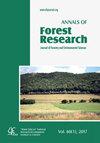Integrated proteomics and histochemical analysis of Araucaria angustifolia (Bertol.) Kuntze (Araucariaceae) in embryogenic suspension culture
IF 1.7
3区 农林科学
Q2 FORESTRY
引用次数: 2
Abstract
t Cell suspension culture is a useful in vitro model-system for both scaling up and conserving the Brazilian conifer Araucaria angustifolia. In the present work, cell suspension of Araucaria was subjected to proteomics, biochemical and histochemical analyses. The results revealed new insights underlying the molecular mechanism of proembryogenic masses transition in cell suspension. Embryogenic cell cultures were cultivated in a basal liquid medium modified in a Steward apparatus (orbital agitator). Cell growth dynamics was evaluated using cell volume after sedimentation, fresh weight, mitotic index, conductivity, pH, and the number of proembryogenic masses (PEMs: I, II, III). Histochemical parameters, cell viability, and cell death analyses were performed to pinpoint growth rates. Proteomics analysis was performed using two-dimensional electrophoresis, and protein identification was carried out by MALDI-TOF-TOF tandem mass spectrometry. Cell growth dynamics showed a predominance of PEM III. Maximum slope of the exponential phase growth in fresh weight occurred at exponential phase after 15 days (optimal cultivation time), after which cell viability and pH decreased, thereby allowing the identification of stressrelated proteins. Several metabolism and growth proteins were abundant, such as: cytoskeletal, WOX1, cytokinin-related, and auxin-related proteins acting on cell wall modification, suspensor cell formation, and PEM I to PEM III transition.狭叶南洋杉(Araucaria angustifolia(Bertol.)Kuntze)胚胎悬浮培养的蛋白质组学和组织化学综合分析
t细胞悬浮培养是一种有用的体外模型系统,用于扩大和保护巴西针叶树南洋杉。本文对南洋杉细胞悬浮液进行了蛋白质组学、生物化学和组织化学分析。这一结果揭示了细胞悬浮液中原胚性物质转移的分子机制的新见解。胚胎细胞培养物在Steward装置(轨道搅拌器)中改良的基础液体培养基中培养。使用沉淀后的细胞体积、鲜重、有丝分裂指数、电导率、pH和原胚性物质的数量(PEM:I、II、III)来评估细胞生长动力学。进行组织化学参数、细胞活力和细胞死亡分析以确定生长速率。蛋白质组学分析采用双向电泳,蛋白质鉴定采用MALDI-TOF-TOF串联质谱法。细胞生长动力学显示出PEM III的优势。鲜重指数期生长的最大斜率出现在15天后的指数期(最佳培养时间),之后细胞活力和pH降低,从而可以鉴定应激相关蛋白。几种代谢和生长蛋白丰富,如:细胞骨架、WOX1、细胞分裂素相关蛋白和生长素相关蛋白,作用于细胞壁修饰、胚柄细胞形成和PEM I至PEM III的转变。
本文章由计算机程序翻译,如有差异,请以英文原文为准。
求助全文
约1分钟内获得全文
求助全文
来源期刊

Annals of Forest Research
FORESTRY-
CiteScore
2.20
自引率
11.10%
发文量
11
审稿时长
12 weeks
期刊介绍:
Annals of Forest Research is a semestrial open access journal, which publishes research articles, research notes and critical review papers, exclusively in English, on topics dealing with forestry and environmental sciences. The journal promotes high scientific level articles, by following international editorial conventions and by applying a peer-review selection process.
 求助内容:
求助内容: 应助结果提醒方式:
应助结果提醒方式:


